Comparison of Information System Development Methods - IMAT3423 Report
VerifiedAdded on 2022/09/01
|18
|4587
|22
Report
AI Summary
This report provides a comprehensive analysis of Information System Development Methodologies (ISDMs) suitable for a software development corporation. It begins with an introduction to ISDMs and their importance in software project success, followed by a case study describing the context, challenges, and benefits of implementing a new business software. The report then discusses various frameworks for evaluating ISDM, including architectural principles and a quality evaluation framework, along with their limitations. The core of the report involves a comparative analysis of different ISDMs, followed by a recommendation for the most suitable method based on the quality evaluation framework, justifying the selection, and providing a critical analysis. The report concludes by summarizing the findings and emphasizing the significance of selecting the right ISDM for successful software development. The assignment adheres to the requirements set by the faculty of technology at De Montfort University for the module IMAT3423.
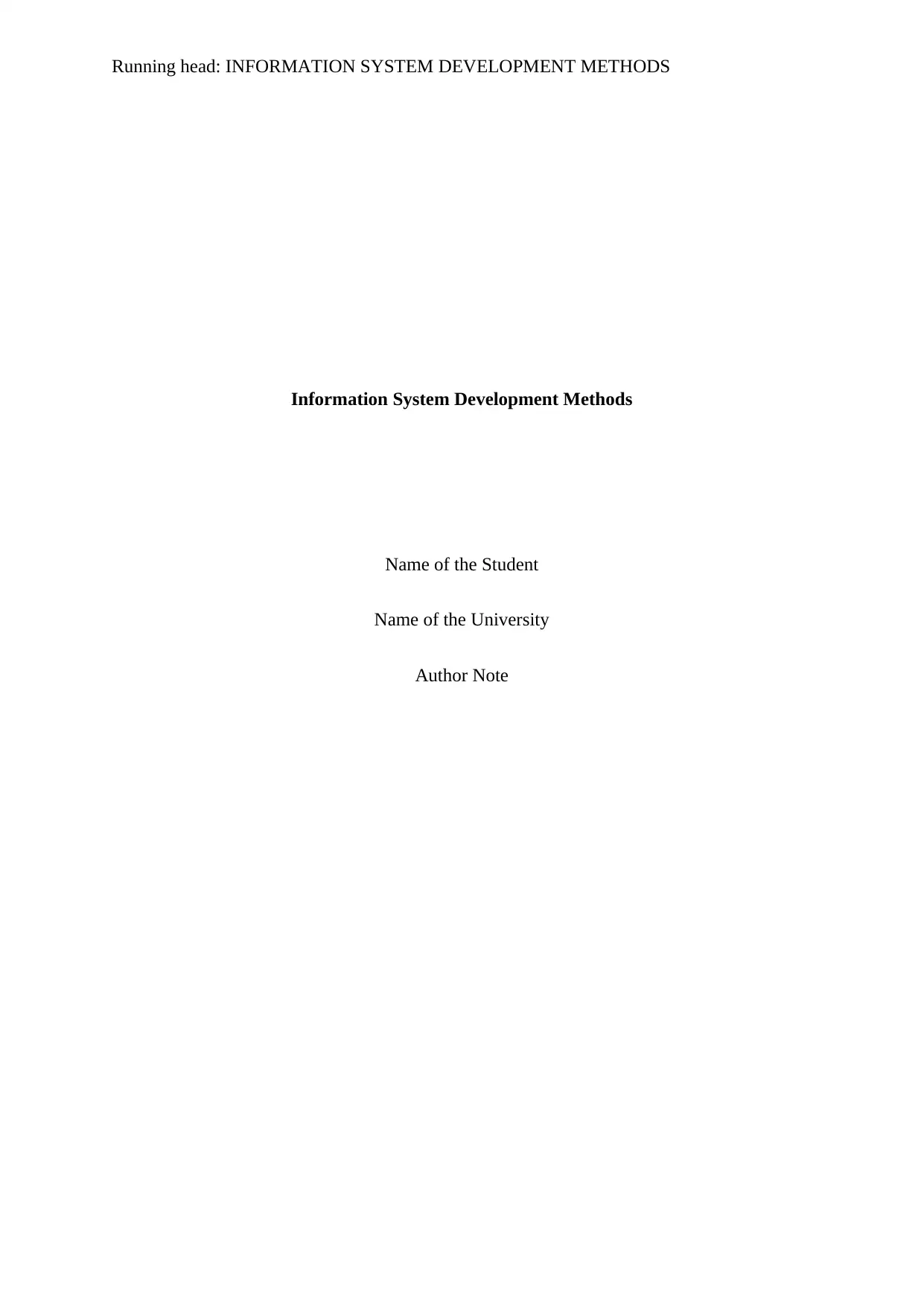
Running head: INFORMATION SYSTEM DEVELOPMENT METHODS
Information System Development Methods
Name of the Student
Name of the University
Author Note
Information System Development Methods
Name of the Student
Name of the University
Author Note
Paraphrase This Document
Need a fresh take? Get an instant paraphrase of this document with our AI Paraphraser
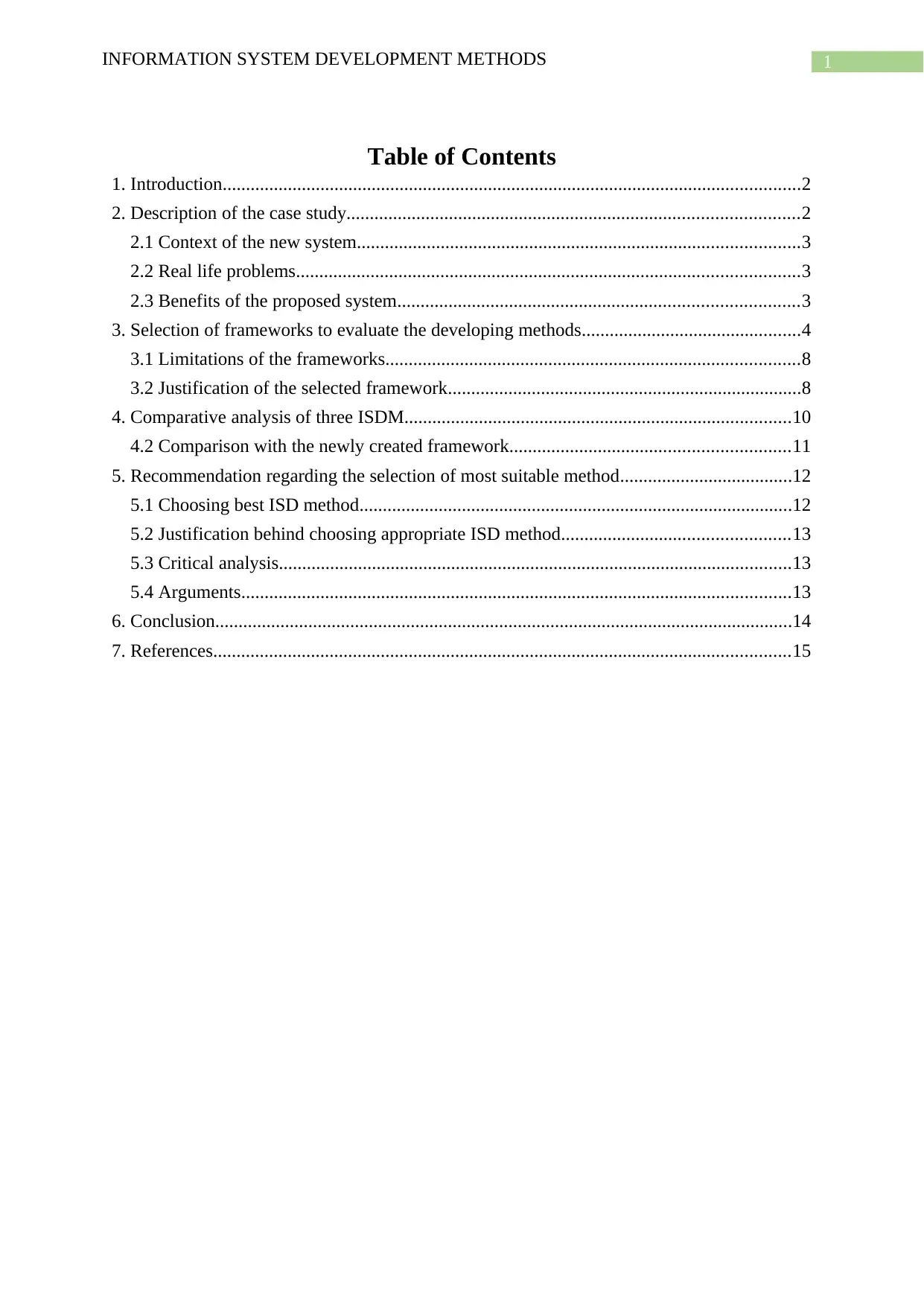
1INFORMATION SYSTEM DEVELOPMENT METHODS
Table of Contents
1. Introduction............................................................................................................................2
2. Description of the case study.................................................................................................2
2.1 Context of the new system...............................................................................................3
2.2 Real life problems............................................................................................................3
2.3 Benefits of the proposed system......................................................................................3
3. Selection of frameworks to evaluate the developing methods...............................................4
3.1 Limitations of the frameworks.........................................................................................8
3.2 Justification of the selected framework............................................................................8
4. Comparative analysis of three ISDM...................................................................................10
4.2 Comparison with the newly created framework............................................................11
5. Recommendation regarding the selection of most suitable method.....................................12
5.1 Choosing best ISD method.............................................................................................12
5.2 Justification behind choosing appropriate ISD method.................................................13
5.3 Critical analysis..............................................................................................................13
5.4 Arguments......................................................................................................................13
6. Conclusion............................................................................................................................14
7. References............................................................................................................................15
Table of Contents
1. Introduction............................................................................................................................2
2. Description of the case study.................................................................................................2
2.1 Context of the new system...............................................................................................3
2.2 Real life problems............................................................................................................3
2.3 Benefits of the proposed system......................................................................................3
3. Selection of frameworks to evaluate the developing methods...............................................4
3.1 Limitations of the frameworks.........................................................................................8
3.2 Justification of the selected framework............................................................................8
4. Comparative analysis of three ISDM...................................................................................10
4.2 Comparison with the newly created framework............................................................11
5. Recommendation regarding the selection of most suitable method.....................................12
5.1 Choosing best ISD method.............................................................................................12
5.2 Justification behind choosing appropriate ISD method.................................................13
5.3 Critical analysis..............................................................................................................13
5.4 Arguments......................................................................................................................13
6. Conclusion............................................................................................................................14
7. References............................................................................................................................15
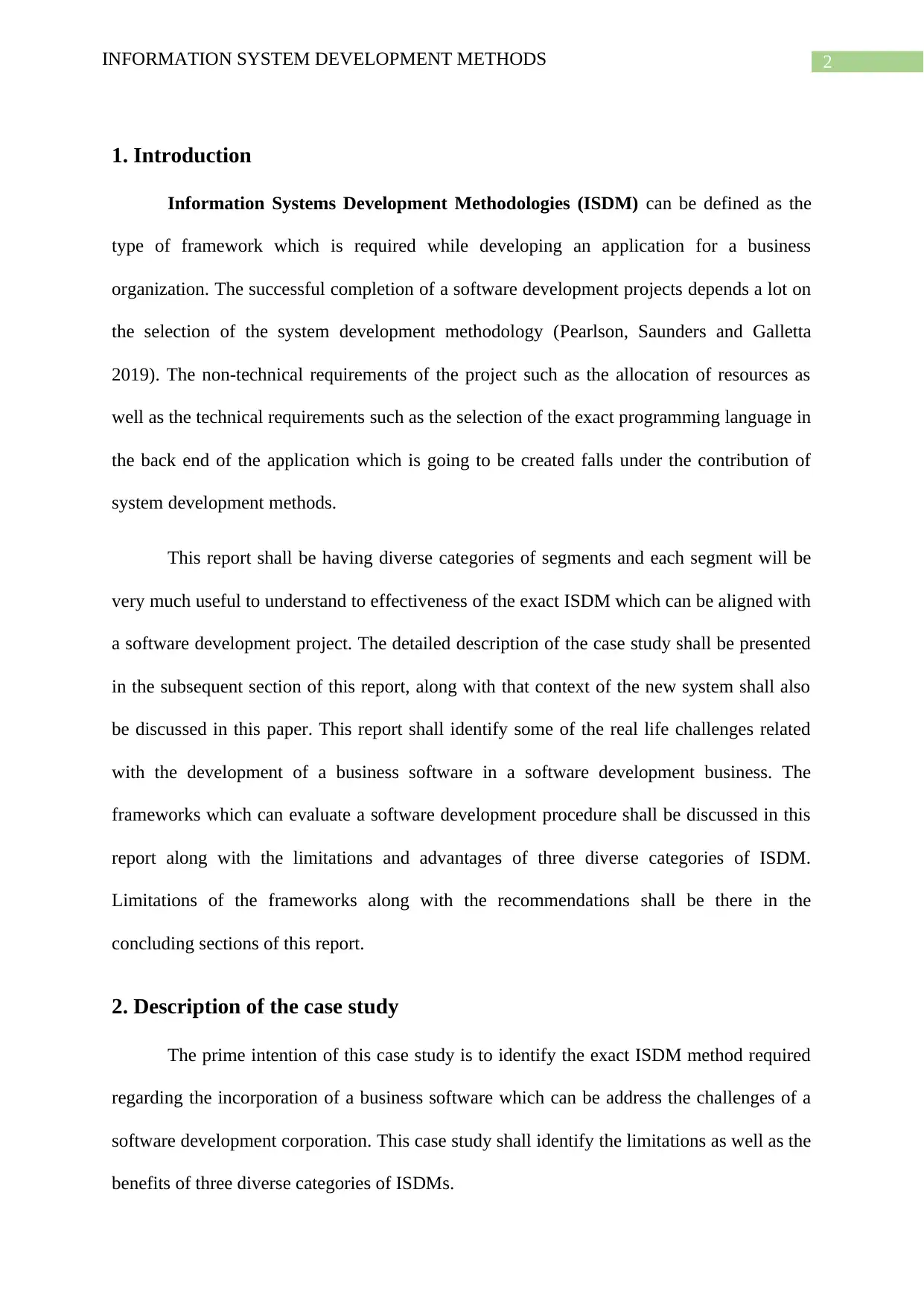
2INFORMATION SYSTEM DEVELOPMENT METHODS
1. Introduction
Information Systems Development Methodologies (ISDM) can be defined as the
type of framework which is required while developing an application for a business
organization. The successful completion of a software development projects depends a lot on
the selection of the system development methodology (Pearlson, Saunders and Galletta
2019). The non-technical requirements of the project such as the allocation of resources as
well as the technical requirements such as the selection of the exact programming language in
the back end of the application which is going to be created falls under the contribution of
system development methods.
This report shall be having diverse categories of segments and each segment will be
very much useful to understand to effectiveness of the exact ISDM which can be aligned with
a software development project. The detailed description of the case study shall be presented
in the subsequent section of this report, along with that context of the new system shall also
be discussed in this paper. This report shall identify some of the real life challenges related
with the development of a business software in a software development business. The
frameworks which can evaluate a software development procedure shall be discussed in this
report along with the limitations and advantages of three diverse categories of ISDM.
Limitations of the frameworks along with the recommendations shall be there in the
concluding sections of this report.
2. Description of the case study
The prime intention of this case study is to identify the exact ISDM method required
regarding the incorporation of a business software which can be address the challenges of a
software development corporation. This case study shall identify the limitations as well as the
benefits of three diverse categories of ISDMs.
1. Introduction
Information Systems Development Methodologies (ISDM) can be defined as the
type of framework which is required while developing an application for a business
organization. The successful completion of a software development projects depends a lot on
the selection of the system development methodology (Pearlson, Saunders and Galletta
2019). The non-technical requirements of the project such as the allocation of resources as
well as the technical requirements such as the selection of the exact programming language in
the back end of the application which is going to be created falls under the contribution of
system development methods.
This report shall be having diverse categories of segments and each segment will be
very much useful to understand to effectiveness of the exact ISDM which can be aligned with
a software development project. The detailed description of the case study shall be presented
in the subsequent section of this report, along with that context of the new system shall also
be discussed in this paper. This report shall identify some of the real life challenges related
with the development of a business software in a software development business. The
frameworks which can evaluate a software development procedure shall be discussed in this
report along with the limitations and advantages of three diverse categories of ISDM.
Limitations of the frameworks along with the recommendations shall be there in the
concluding sections of this report.
2. Description of the case study
The prime intention of this case study is to identify the exact ISDM method required
regarding the incorporation of a business software which can be address the challenges of a
software development corporation. This case study shall identify the limitations as well as the
benefits of three diverse categories of ISDMs.
⊘ This is a preview!⊘
Do you want full access?
Subscribe today to unlock all pages.

Trusted by 1+ million students worldwide
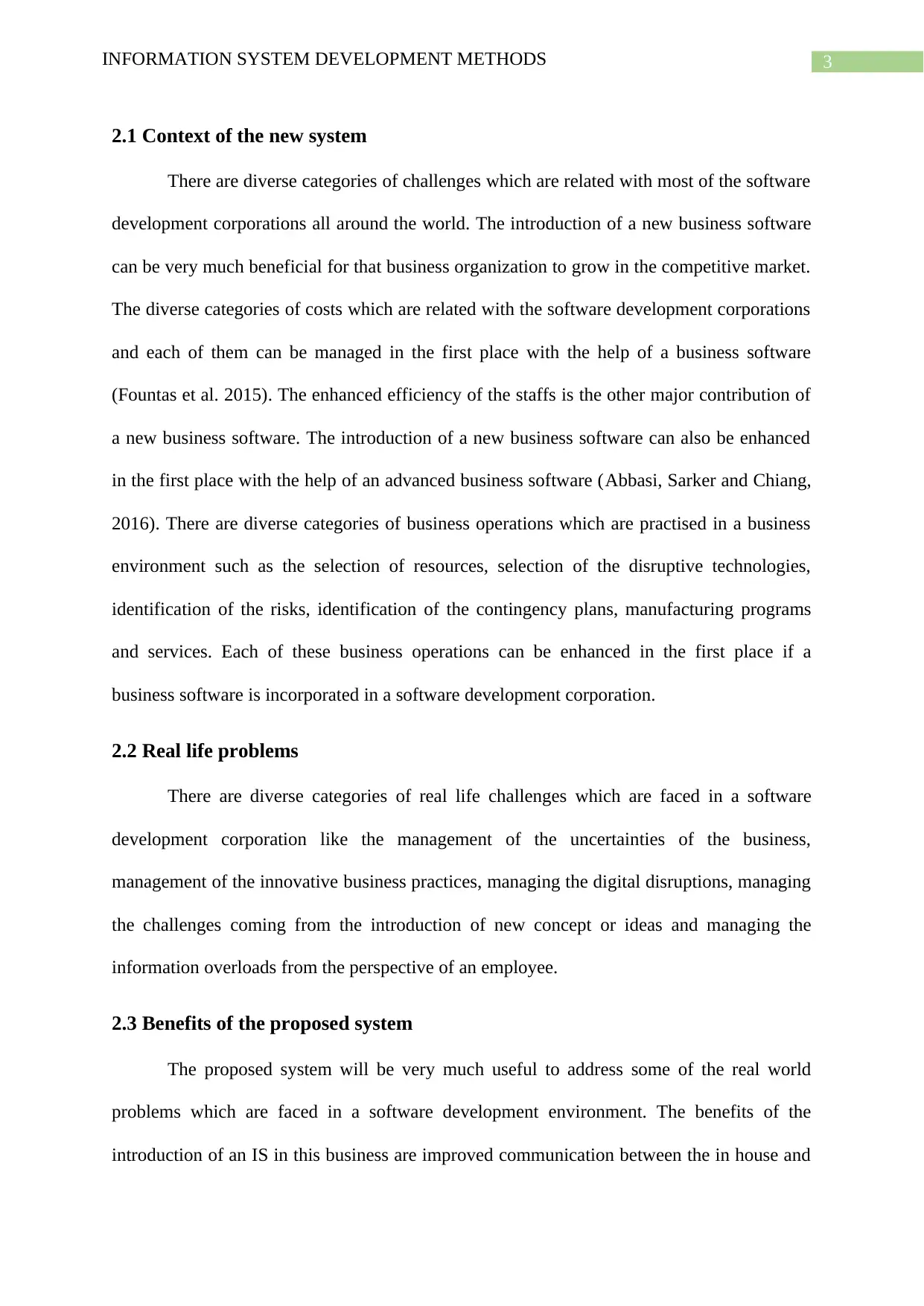
3INFORMATION SYSTEM DEVELOPMENT METHODS
2.1 Context of the new system
There are diverse categories of challenges which are related with most of the software
development corporations all around the world. The introduction of a new business software
can be very much beneficial for that business organization to grow in the competitive market.
The diverse categories of costs which are related with the software development corporations
and each of them can be managed in the first place with the help of a business software
(Fountas et al. 2015). The enhanced efficiency of the staffs is the other major contribution of
a new business software. The introduction of a new business software can also be enhanced
in the first place with the help of an advanced business software (Abbasi, Sarker and Chiang,
2016). There are diverse categories of business operations which are practised in a business
environment such as the selection of resources, selection of the disruptive technologies,
identification of the risks, identification of the contingency plans, manufacturing programs
and services. Each of these business operations can be enhanced in the first place if a
business software is incorporated in a software development corporation.
2.2 Real life problems
There are diverse categories of real life challenges which are faced in a software
development corporation like the management of the uncertainties of the business,
management of the innovative business practices, managing the digital disruptions, managing
the challenges coming from the introduction of new concept or ideas and managing the
information overloads from the perspective of an employee.
2.3 Benefits of the proposed system
The proposed system will be very much useful to address some of the real world
problems which are faced in a software development environment. The benefits of the
introduction of an IS in this business are improved communication between the in house and
2.1 Context of the new system
There are diverse categories of challenges which are related with most of the software
development corporations all around the world. The introduction of a new business software
can be very much beneficial for that business organization to grow in the competitive market.
The diverse categories of costs which are related with the software development corporations
and each of them can be managed in the first place with the help of a business software
(Fountas et al. 2015). The enhanced efficiency of the staffs is the other major contribution of
a new business software. The introduction of a new business software can also be enhanced
in the first place with the help of an advanced business software (Abbasi, Sarker and Chiang,
2016). There are diverse categories of business operations which are practised in a business
environment such as the selection of resources, selection of the disruptive technologies,
identification of the risks, identification of the contingency plans, manufacturing programs
and services. Each of these business operations can be enhanced in the first place if a
business software is incorporated in a software development corporation.
2.2 Real life problems
There are diverse categories of real life challenges which are faced in a software
development corporation like the management of the uncertainties of the business,
management of the innovative business practices, managing the digital disruptions, managing
the challenges coming from the introduction of new concept or ideas and managing the
information overloads from the perspective of an employee.
2.3 Benefits of the proposed system
The proposed system will be very much useful to address some of the real world
problems which are faced in a software development environment. The benefits of the
introduction of an IS in this business are improved communication between the in house and
Paraphrase This Document
Need a fresh take? Get an instant paraphrase of this document with our AI Paraphraser
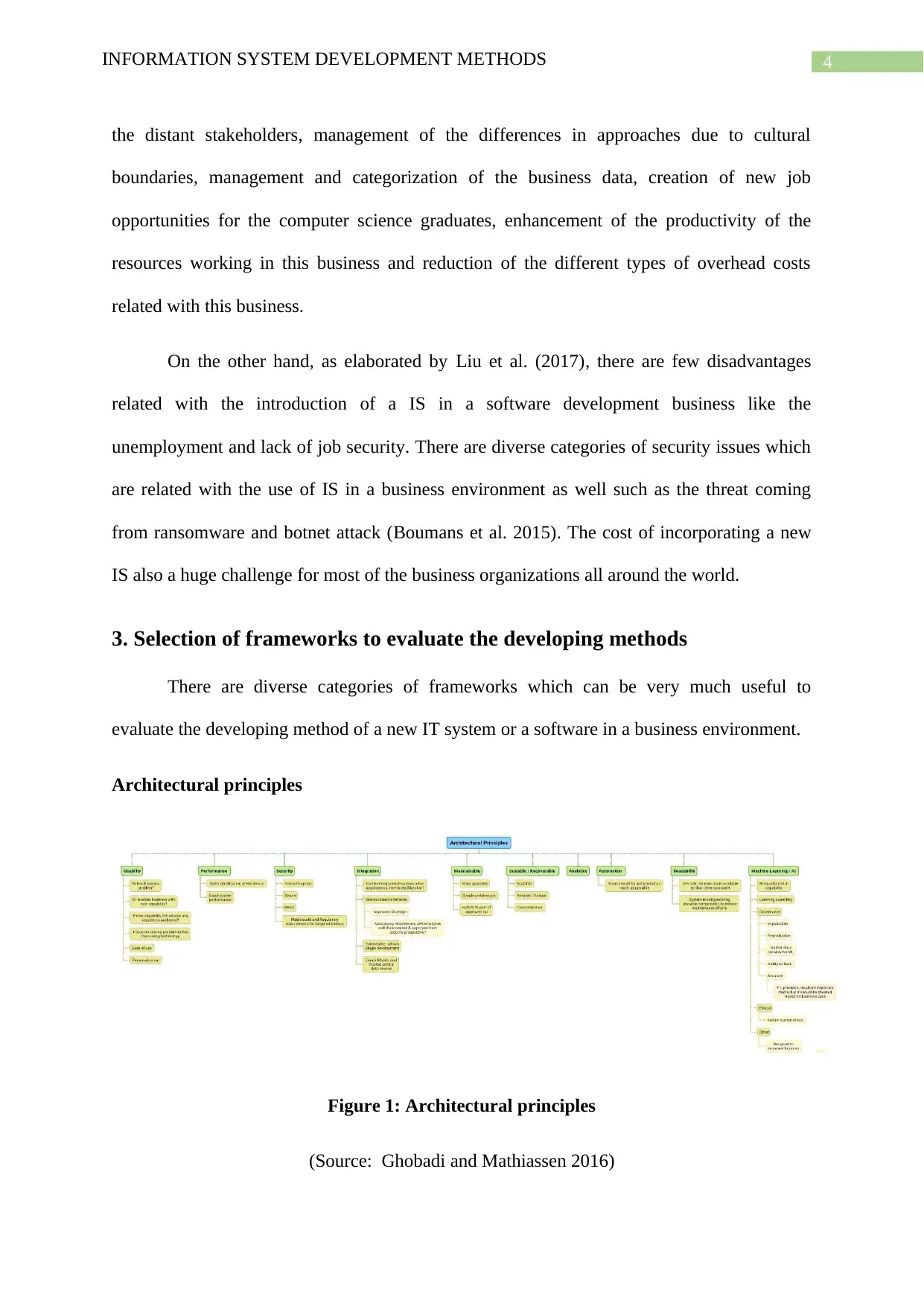
4INFORMATION SYSTEM DEVELOPMENT METHODS
the distant stakeholders, management of the differences in approaches due to cultural
boundaries, management and categorization of the business data, creation of new job
opportunities for the computer science graduates, enhancement of the productivity of the
resources working in this business and reduction of the different types of overhead costs
related with this business.
On the other hand, as elaborated by Liu et al. (2017), there are few disadvantages
related with the introduction of a IS in a software development business like the
unemployment and lack of job security. There are diverse categories of security issues which
are related with the use of IS in a business environment as well such as the threat coming
from ransomware and botnet attack (Boumans et al. 2015). The cost of incorporating a new
IS also a huge challenge for most of the business organizations all around the world.
3. Selection of frameworks to evaluate the developing methods
There are diverse categories of frameworks which can be very much useful to
evaluate the developing method of a new IT system or a software in a business environment.
Architectural principles
Figure 1: Architectural principles
(Source: Ghobadi and Mathiassen 2016)
the distant stakeholders, management of the differences in approaches due to cultural
boundaries, management and categorization of the business data, creation of new job
opportunities for the computer science graduates, enhancement of the productivity of the
resources working in this business and reduction of the different types of overhead costs
related with this business.
On the other hand, as elaborated by Liu et al. (2017), there are few disadvantages
related with the introduction of a IS in a software development business like the
unemployment and lack of job security. There are diverse categories of security issues which
are related with the use of IS in a business environment as well such as the threat coming
from ransomware and botnet attack (Boumans et al. 2015). The cost of incorporating a new
IS also a huge challenge for most of the business organizations all around the world.
3. Selection of frameworks to evaluate the developing methods
There are diverse categories of frameworks which can be very much useful to
evaluate the developing method of a new IT system or a software in a business environment.
Architectural principles
Figure 1: Architectural principles
(Source: Ghobadi and Mathiassen 2016)
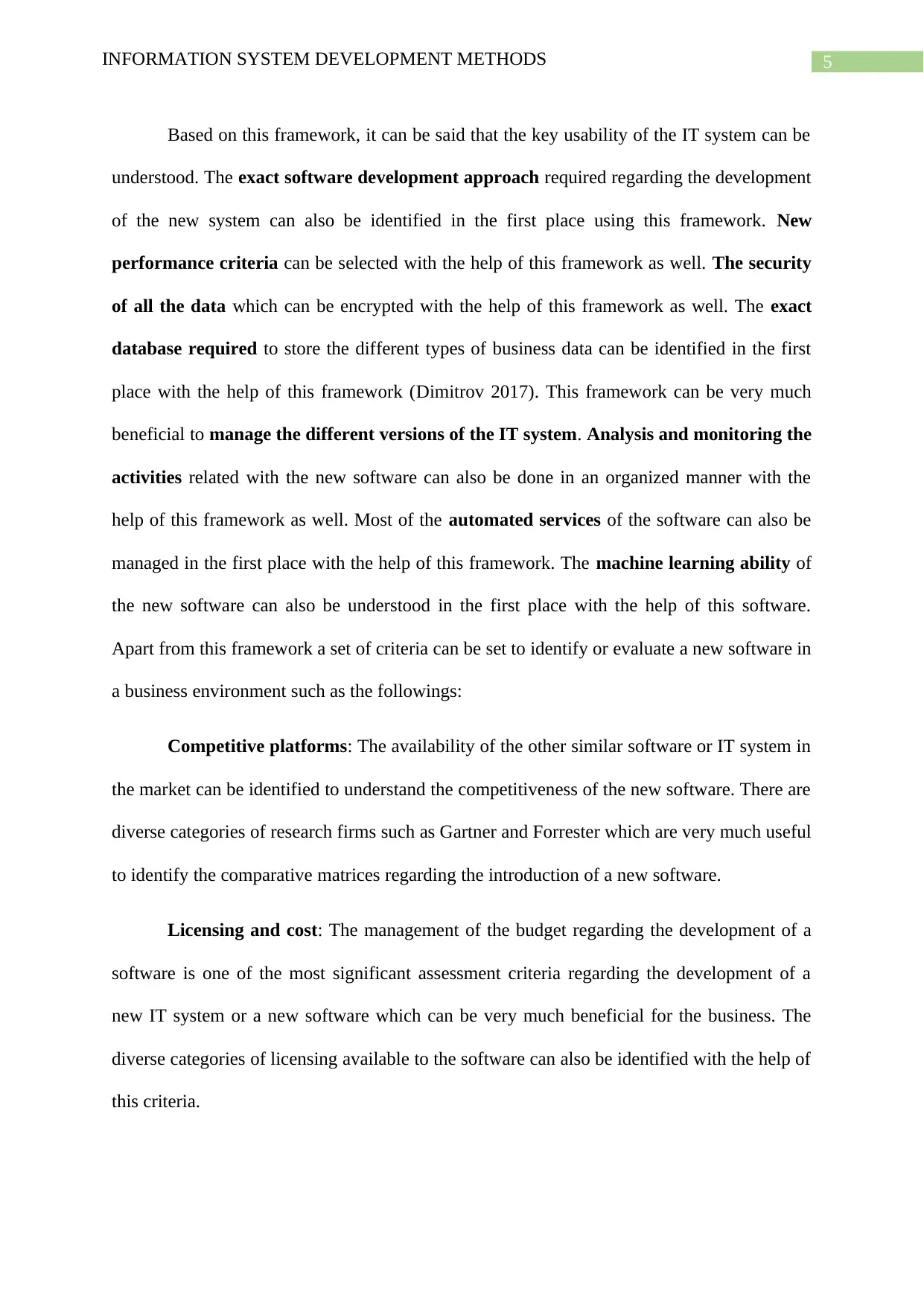
5INFORMATION SYSTEM DEVELOPMENT METHODS
Based on this framework, it can be said that the key usability of the IT system can be
understood. The exact software development approach required regarding the development
of the new system can also be identified in the first place using this framework. New
performance criteria can be selected with the help of this framework as well. The security
of all the data which can be encrypted with the help of this framework as well. The exact
database required to store the different types of business data can be identified in the first
place with the help of this framework (Dimitrov 2017). This framework can be very much
beneficial to manage the different versions of the IT system. Analysis and monitoring the
activities related with the new software can also be done in an organized manner with the
help of this framework as well. Most of the automated services of the software can also be
managed in the first place with the help of this framework. The machine learning ability of
the new software can also be understood in the first place with the help of this software.
Apart from this framework a set of criteria can be set to identify or evaluate a new software in
a business environment such as the followings:
Competitive platforms: The availability of the other similar software or IT system in
the market can be identified to understand the competitiveness of the new software. There are
diverse categories of research firms such as Gartner and Forrester which are very much useful
to identify the comparative matrices regarding the introduction of a new software.
Licensing and cost: The management of the budget regarding the development of a
software is one of the most significant assessment criteria regarding the development of a
new IT system or a new software which can be very much beneficial for the business. The
diverse categories of licensing available to the software can also be identified with the help of
this criteria.
Based on this framework, it can be said that the key usability of the IT system can be
understood. The exact software development approach required regarding the development
of the new system can also be identified in the first place using this framework. New
performance criteria can be selected with the help of this framework as well. The security
of all the data which can be encrypted with the help of this framework as well. The exact
database required to store the different types of business data can be identified in the first
place with the help of this framework (Dimitrov 2017). This framework can be very much
beneficial to manage the different versions of the IT system. Analysis and monitoring the
activities related with the new software can also be done in an organized manner with the
help of this framework as well. Most of the automated services of the software can also be
managed in the first place with the help of this framework. The machine learning ability of
the new software can also be understood in the first place with the help of this software.
Apart from this framework a set of criteria can be set to identify or evaluate a new software in
a business environment such as the followings:
Competitive platforms: The availability of the other similar software or IT system in
the market can be identified to understand the competitiveness of the new software. There are
diverse categories of research firms such as Gartner and Forrester which are very much useful
to identify the comparative matrices regarding the introduction of a new software.
Licensing and cost: The management of the budget regarding the development of a
software is one of the most significant assessment criteria regarding the development of a
new IT system or a new software which can be very much beneficial for the business. The
diverse categories of licensing available to the software can also be identified with the help of
this criteria.
⊘ This is a preview!⊘
Do you want full access?
Subscribe today to unlock all pages.

Trusted by 1+ million students worldwide
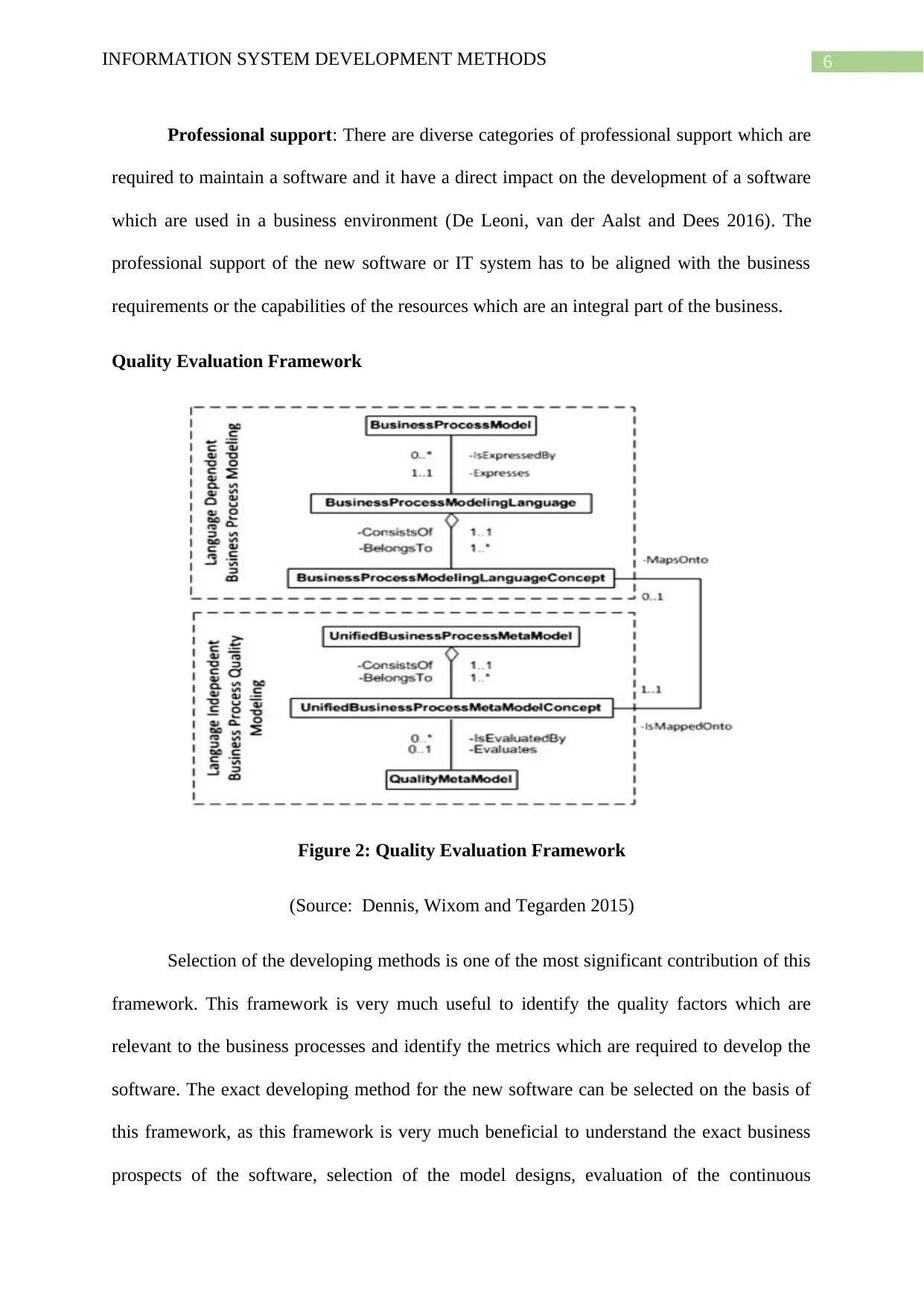
6INFORMATION SYSTEM DEVELOPMENT METHODS
Professional support: There are diverse categories of professional support which are
required to maintain a software and it have a direct impact on the development of a software
which are used in a business environment (De Leoni, van der Aalst and Dees 2016). The
professional support of the new software or IT system has to be aligned with the business
requirements or the capabilities of the resources which are an integral part of the business.
Quality Evaluation Framework
Figure 2: Quality Evaluation Framework
(Source: Dennis, Wixom and Tegarden 2015)
Selection of the developing methods is one of the most significant contribution of this
framework. This framework is very much useful to identify the quality factors which are
relevant to the business processes and identify the metrics which are required to develop the
software. The exact developing method for the new software can be selected on the basis of
this framework, as this framework is very much beneficial to understand the exact business
prospects of the software, selection of the model designs, evaluation of the continuous
Professional support: There are diverse categories of professional support which are
required to maintain a software and it have a direct impact on the development of a software
which are used in a business environment (De Leoni, van der Aalst and Dees 2016). The
professional support of the new software or IT system has to be aligned with the business
requirements or the capabilities of the resources which are an integral part of the business.
Quality Evaluation Framework
Figure 2: Quality Evaluation Framework
(Source: Dennis, Wixom and Tegarden 2015)
Selection of the developing methods is one of the most significant contribution of this
framework. This framework is very much useful to identify the quality factors which are
relevant to the business processes and identify the metrics which are required to develop the
software. The exact developing method for the new software can be selected on the basis of
this framework, as this framework is very much beneficial to understand the exact business
prospects of the software, selection of the model designs, evaluation of the continuous
Paraphrase This Document
Need a fresh take? Get an instant paraphrase of this document with our AI Paraphraser
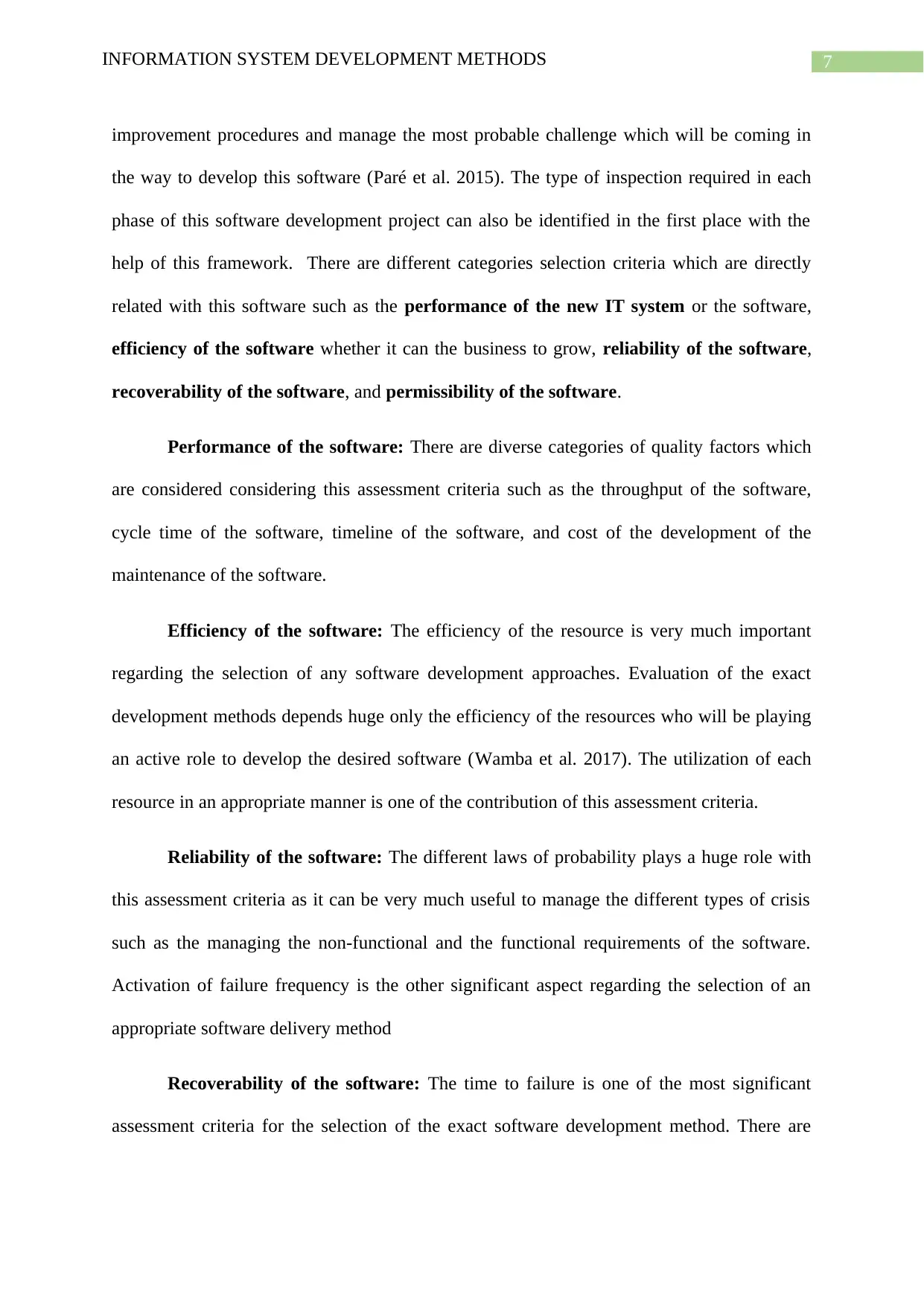
7INFORMATION SYSTEM DEVELOPMENT METHODS
improvement procedures and manage the most probable challenge which will be coming in
the way to develop this software (Paré et al. 2015). The type of inspection required in each
phase of this software development project can also be identified in the first place with the
help of this framework. There are different categories selection criteria which are directly
related with this software such as the performance of the new IT system or the software,
efficiency of the software whether it can the business to grow, reliability of the software,
recoverability of the software, and permissibility of the software.
Performance of the software: There are diverse categories of quality factors which
are considered considering this assessment criteria such as the throughput of the software,
cycle time of the software, timeline of the software, and cost of the development of the
maintenance of the software.
Efficiency of the software: The efficiency of the resource is very much important
regarding the selection of any software development approaches. Evaluation of the exact
development methods depends huge only the efficiency of the resources who will be playing
an active role to develop the desired software (Wamba et al. 2017). The utilization of each
resource in an appropriate manner is one of the contribution of this assessment criteria.
Reliability of the software: The different laws of probability plays a huge role with
this assessment criteria as it can be very much useful to manage the different types of crisis
such as the managing the non-functional and the functional requirements of the software.
Activation of failure frequency is the other significant aspect regarding the selection of an
appropriate software delivery method
Recoverability of the software: The time to failure is one of the most significant
assessment criteria for the selection of the exact software development method. There are
improvement procedures and manage the most probable challenge which will be coming in
the way to develop this software (Paré et al. 2015). The type of inspection required in each
phase of this software development project can also be identified in the first place with the
help of this framework. There are different categories selection criteria which are directly
related with this software such as the performance of the new IT system or the software,
efficiency of the software whether it can the business to grow, reliability of the software,
recoverability of the software, and permissibility of the software.
Performance of the software: There are diverse categories of quality factors which
are considered considering this assessment criteria such as the throughput of the software,
cycle time of the software, timeline of the software, and cost of the development of the
maintenance of the software.
Efficiency of the software: The efficiency of the resource is very much important
regarding the selection of any software development approaches. Evaluation of the exact
development methods depends huge only the efficiency of the resources who will be playing
an active role to develop the desired software (Wamba et al. 2017). The utilization of each
resource in an appropriate manner is one of the contribution of this assessment criteria.
Reliability of the software: The different laws of probability plays a huge role with
this assessment criteria as it can be very much useful to manage the different types of crisis
such as the managing the non-functional and the functional requirements of the software.
Activation of failure frequency is the other significant aspect regarding the selection of an
appropriate software delivery method
Recoverability of the software: The time to failure is one of the most significant
assessment criteria for the selection of the exact software development method. There are
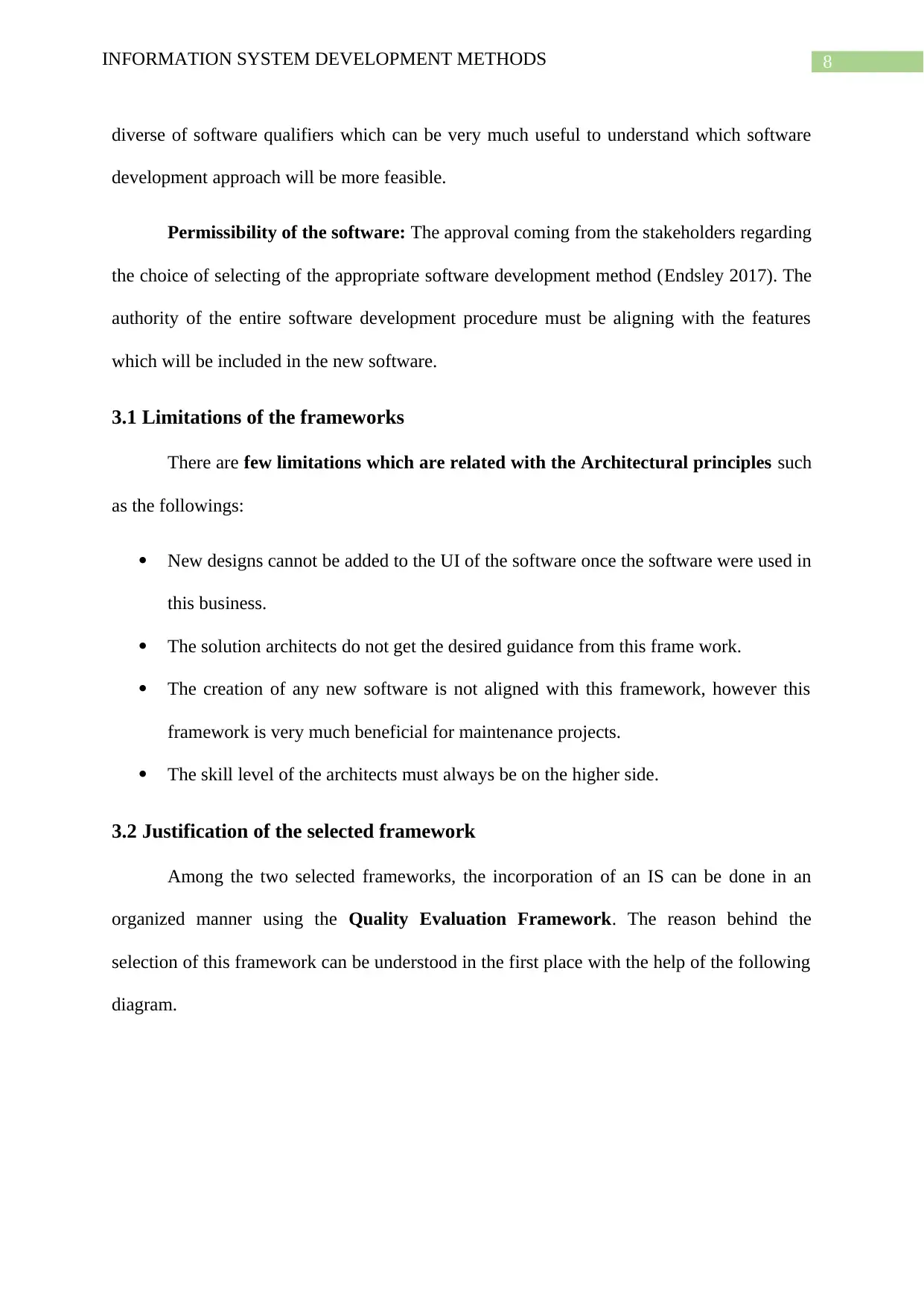
8INFORMATION SYSTEM DEVELOPMENT METHODS
diverse of software qualifiers which can be very much useful to understand which software
development approach will be more feasible.
Permissibility of the software: The approval coming from the stakeholders regarding
the choice of selecting of the appropriate software development method (Endsley 2017). The
authority of the entire software development procedure must be aligning with the features
which will be included in the new software.
3.1 Limitations of the frameworks
There are few limitations which are related with the Architectural principles such
as the followings:
New designs cannot be added to the UI of the software once the software were used in
this business.
The solution architects do not get the desired guidance from this frame work.
The creation of any new software is not aligned with this framework, however this
framework is very much beneficial for maintenance projects.
The skill level of the architects must always be on the higher side.
3.2 Justification of the selected framework
Among the two selected frameworks, the incorporation of an IS can be done in an
organized manner using the Quality Evaluation Framework. The reason behind the
selection of this framework can be understood in the first place with the help of the following
diagram.
diverse of software qualifiers which can be very much useful to understand which software
development approach will be more feasible.
Permissibility of the software: The approval coming from the stakeholders regarding
the choice of selecting of the appropriate software development method (Endsley 2017). The
authority of the entire software development procedure must be aligning with the features
which will be included in the new software.
3.1 Limitations of the frameworks
There are few limitations which are related with the Architectural principles such
as the followings:
New designs cannot be added to the UI of the software once the software were used in
this business.
The solution architects do not get the desired guidance from this frame work.
The creation of any new software is not aligned with this framework, however this
framework is very much beneficial for maintenance projects.
The skill level of the architects must always be on the higher side.
3.2 Justification of the selected framework
Among the two selected frameworks, the incorporation of an IS can be done in an
organized manner using the Quality Evaluation Framework. The reason behind the
selection of this framework can be understood in the first place with the help of the following
diagram.
⊘ This is a preview!⊘
Do you want full access?
Subscribe today to unlock all pages.

Trusted by 1+ million students worldwide
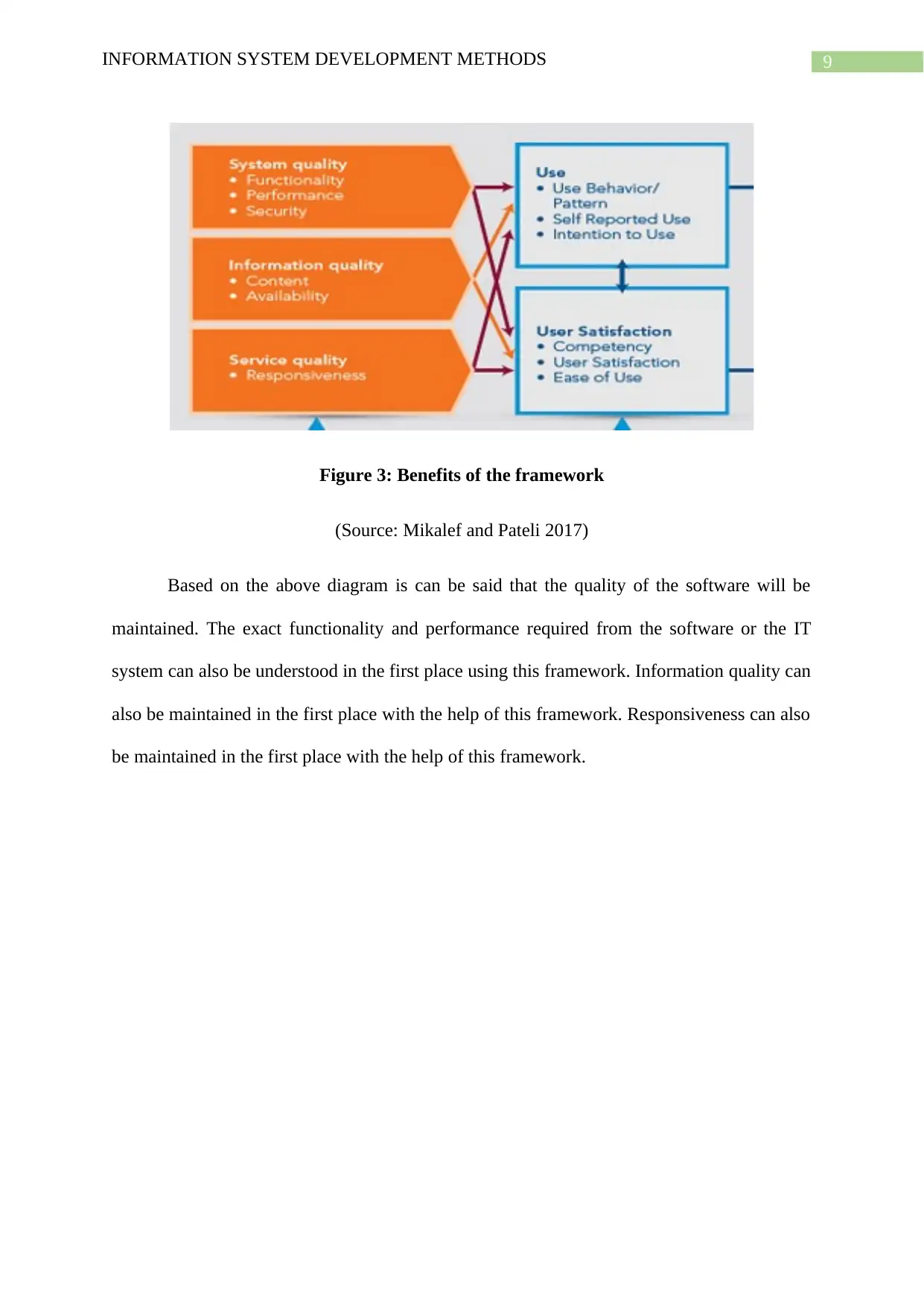
9INFORMATION SYSTEM DEVELOPMENT METHODS
Figure 3: Benefits of the framework
(Source: Mikalef and Pateli 2017)
Based on the above diagram is can be said that the quality of the software will be
maintained. The exact functionality and performance required from the software or the IT
system can also be understood in the first place using this framework. Information quality can
also be maintained in the first place with the help of this framework. Responsiveness can also
be maintained in the first place with the help of this framework.
Figure 3: Benefits of the framework
(Source: Mikalef and Pateli 2017)
Based on the above diagram is can be said that the quality of the software will be
maintained. The exact functionality and performance required from the software or the IT
system can also be understood in the first place using this framework. Information quality can
also be maintained in the first place with the help of this framework. Responsiveness can also
be maintained in the first place with the help of this framework.
Paraphrase This Document
Need a fresh take? Get an instant paraphrase of this document with our AI Paraphraser
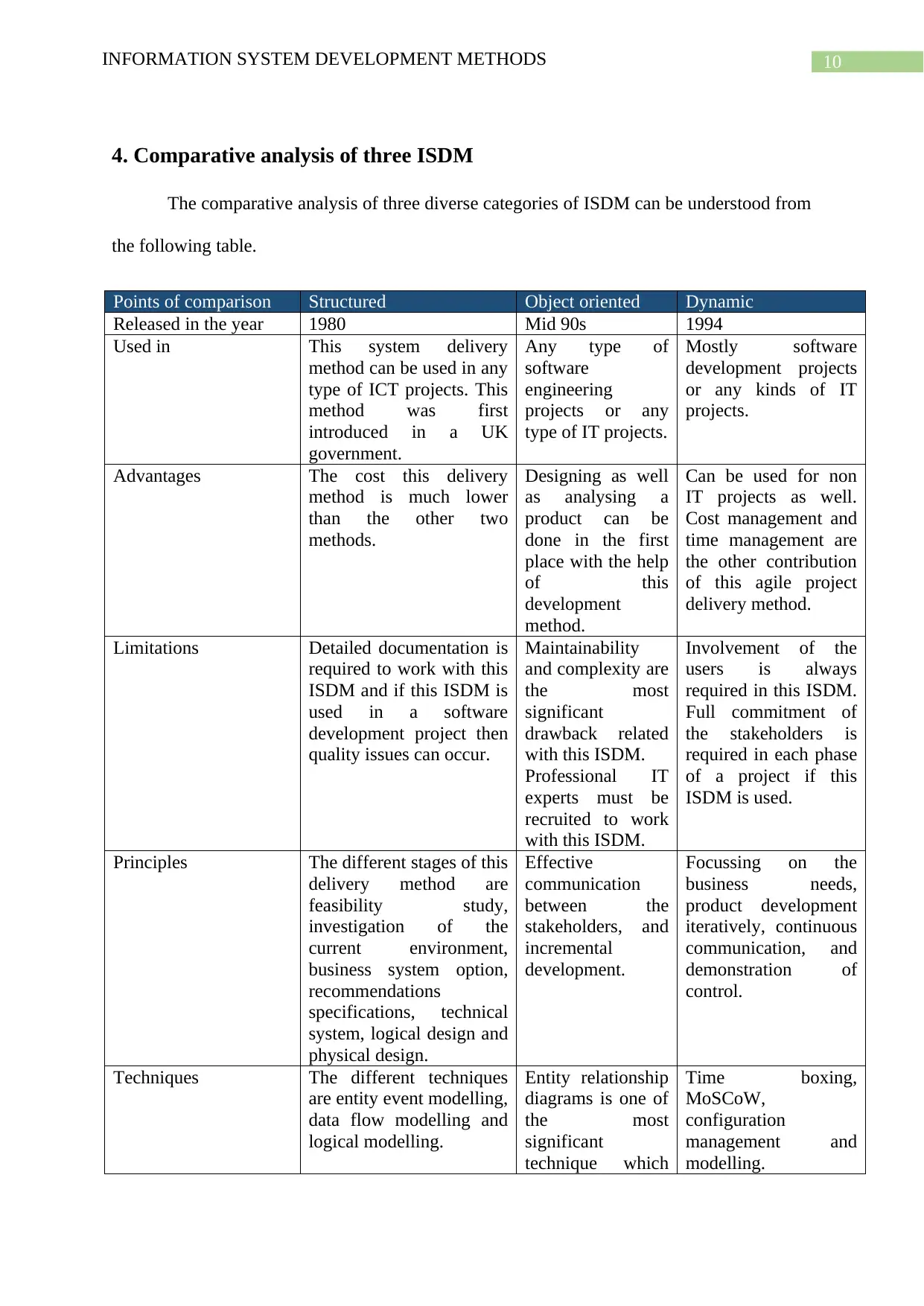
10INFORMATION SYSTEM DEVELOPMENT METHODS
4. Comparative analysis of three ISDM
The comparative analysis of three diverse categories of ISDM can be understood from
the following table.
Points of comparison Structured Object oriented Dynamic
Released in the year 1980 Mid 90s 1994
Used in This system delivery
method can be used in any
type of ICT projects. This
method was first
introduced in a UK
government.
Any type of
software
engineering
projects or any
type of IT projects.
Mostly software
development projects
or any kinds of IT
projects.
Advantages The cost this delivery
method is much lower
than the other two
methods.
Designing as well
as analysing a
product can be
done in the first
place with the help
of this
development
method.
Can be used for non
IT projects as well.
Cost management and
time management are
the other contribution
of this agile project
delivery method.
Limitations Detailed documentation is
required to work with this
ISDM and if this ISDM is
used in a software
development project then
quality issues can occur.
Maintainability
and complexity are
the most
significant
drawback related
with this ISDM.
Professional IT
experts must be
recruited to work
with this ISDM.
Involvement of the
users is always
required in this ISDM.
Full commitment of
the stakeholders is
required in each phase
of a project if this
ISDM is used.
Principles The different stages of this
delivery method are
feasibility study,
investigation of the
current environment,
business system option,
recommendations
specifications, technical
system, logical design and
physical design.
Effective
communication
between the
stakeholders, and
incremental
development.
Focussing on the
business needs,
product development
iteratively, continuous
communication, and
demonstration of
control.
Techniques The different techniques
are entity event modelling,
data flow modelling and
logical modelling.
Entity relationship
diagrams is one of
the most
significant
technique which
Time boxing,
MoSCoW,
configuration
management and
modelling.
4. Comparative analysis of three ISDM
The comparative analysis of three diverse categories of ISDM can be understood from
the following table.
Points of comparison Structured Object oriented Dynamic
Released in the year 1980 Mid 90s 1994
Used in This system delivery
method can be used in any
type of ICT projects. This
method was first
introduced in a UK
government.
Any type of
software
engineering
projects or any
type of IT projects.
Mostly software
development projects
or any kinds of IT
projects.
Advantages The cost this delivery
method is much lower
than the other two
methods.
Designing as well
as analysing a
product can be
done in the first
place with the help
of this
development
method.
Can be used for non
IT projects as well.
Cost management and
time management are
the other contribution
of this agile project
delivery method.
Limitations Detailed documentation is
required to work with this
ISDM and if this ISDM is
used in a software
development project then
quality issues can occur.
Maintainability
and complexity are
the most
significant
drawback related
with this ISDM.
Professional IT
experts must be
recruited to work
with this ISDM.
Involvement of the
users is always
required in this ISDM.
Full commitment of
the stakeholders is
required in each phase
of a project if this
ISDM is used.
Principles The different stages of this
delivery method are
feasibility study,
investigation of the
current environment,
business system option,
recommendations
specifications, technical
system, logical design and
physical design.
Effective
communication
between the
stakeholders, and
incremental
development.
Focussing on the
business needs,
product development
iteratively, continuous
communication, and
demonstration of
control.
Techniques The different techniques
are entity event modelling,
data flow modelling and
logical modelling.
Entity relationship
diagrams is one of
the most
significant
technique which
Time boxing,
MoSCoW,
configuration
management and
modelling.
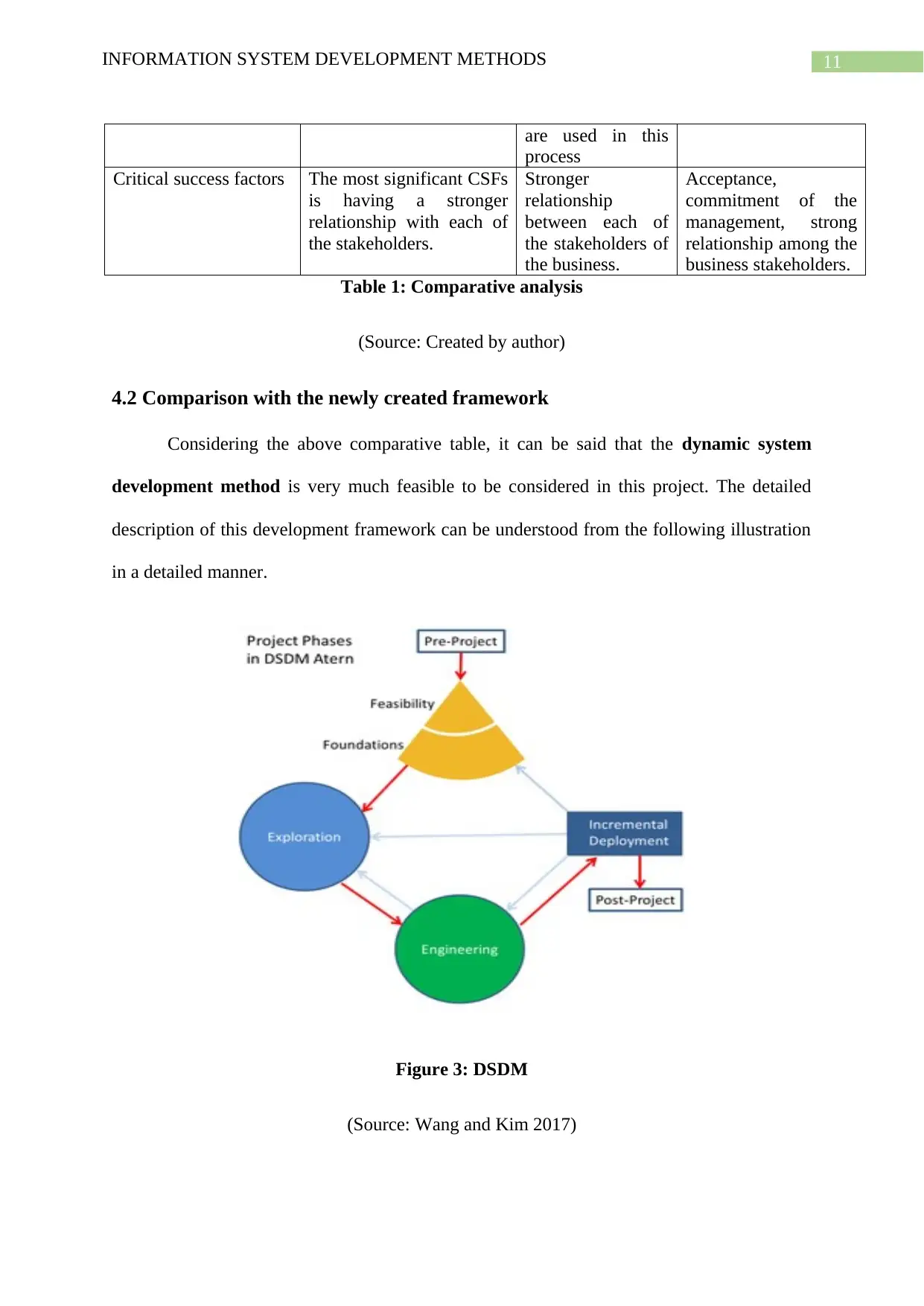
11INFORMATION SYSTEM DEVELOPMENT METHODS
are used in this
process
Critical success factors The most significant CSFs
is having a stronger
relationship with each of
the stakeholders.
Stronger
relationship
between each of
the stakeholders of
the business.
Acceptance,
commitment of the
management, strong
relationship among the
business stakeholders.
Table 1: Comparative analysis
(Source: Created by author)
4.2 Comparison with the newly created framework
Considering the above comparative table, it can be said that the dynamic system
development method is very much feasible to be considered in this project. The detailed
description of this development framework can be understood from the following illustration
in a detailed manner.
Figure 3: DSDM
(Source: Wang and Kim 2017)
are used in this
process
Critical success factors The most significant CSFs
is having a stronger
relationship with each of
the stakeholders.
Stronger
relationship
between each of
the stakeholders of
the business.
Acceptance,
commitment of the
management, strong
relationship among the
business stakeholders.
Table 1: Comparative analysis
(Source: Created by author)
4.2 Comparison with the newly created framework
Considering the above comparative table, it can be said that the dynamic system
development method is very much feasible to be considered in this project. The detailed
description of this development framework can be understood from the following illustration
in a detailed manner.
Figure 3: DSDM
(Source: Wang and Kim 2017)
⊘ This is a preview!⊘
Do you want full access?
Subscribe today to unlock all pages.

Trusted by 1+ million students worldwide
1 out of 18
Related Documents
Your All-in-One AI-Powered Toolkit for Academic Success.
+13062052269
info@desklib.com
Available 24*7 on WhatsApp / Email
![[object Object]](/_next/static/media/star-bottom.7253800d.svg)
Unlock your academic potential
Copyright © 2020–2025 A2Z Services. All Rights Reserved. Developed and managed by ZUCOL.




